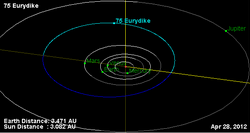Astronomy:75 Eurydike
From HandWiki
Short description: Main-belt asteroid
 Orbital diagram | |
| Discovery | |
|---|---|
| Discovered by | Christian Heinrich Friedrich Peters |
| Discovery date | September 22, 1862 |
| Designations | |
| (75) Eurydike | |
| Pronunciation | /jʊˈrɪdɪkiː/[1] |
| Named after | Eurydice |
| Minor planet category | Main belt |
| Adjectives | Eurydikean /ˌjʊərɪdɪˈkiːən/ |
| Orbital characteristics | |
| Epoch December 31, 2006 (JD 2454100.5) | |
| |{{{apsis}}}|helion}} | 521.874 Gm (3.489 AU) |
| |{{{apsis}}}|helion}} | 278.028 Gm (1.858 AU) |
| 399.951 Gm (2.674 AU) | |
| Eccentricity | 0.305 |
| Orbital period | 1596.687 d (4.37 a) |
| Average Orbital speed | 17.79 km/s |
| Mean anomaly | 26.318° |
| Inclination | 5.002° |
| Longitude of ascending node | 359.481° |
| 339.566° | |
| Physical characteristics | |
| Dimensions | 55.7 km |
| Mass | 1.8×1017 kg |
| Rotation period | 5.357 h |
| Geometric albedo | 0.149 [2] |
| M[3] | |
| Absolute magnitude (H) | 8.96 |
Eurydike (minor planet designation: 75 Eurydike) is a large main-belt asteroid. It has an M-type spectrum and a relatively high albedo and may be rich in nickel-iron.[3] Eurydike was discovered by German-American astronomer C. H. F. Peters on September 22, 1862. It was second of his numerous asteroid discoveries and is named after Eurydice, the wife of Orpheus. The asteroid is orbiting the Sun for a period of 4.37 years and completes a rotation about its axis every 5.4 hours.
References
- ↑ 'Eurydice' in Noah Webster (1884) A Practical Dictionary of the English Language
- ↑ Asteroid Data Sets
- ↑ 3.0 3.1 Busarev, V. V. (January 1998). "Spectral Features of M-Asteroids: 75 Eurydike and 201 Penelope". Icarus 131 (1): 32–40. doi:10.1006/icar.1997.5847. Bibcode: 1998Icar..131...32B.
External links
- 75 Eurydike at AstDyS-2, Asteroids—Dynamic Site
- 75 Eurydike at the JPL Small-Body Database
 |

